-
ULRICH KOHLER: IN MY ROOM (2018)
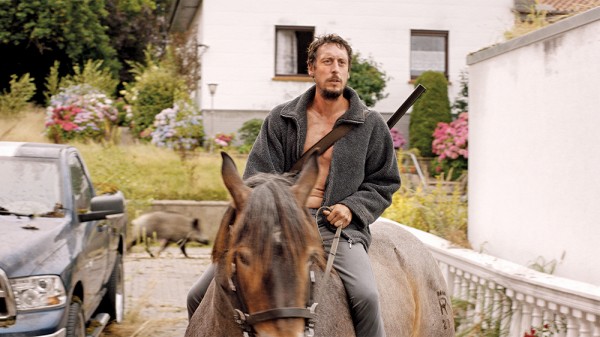
HANS LÖW IN IN MY ROOM
Muddling toward heroism
While I had trouble getting a grip on Köhler's previous film, the 2011 <a href="http://www.chrisknipp.com/writing/viewtopic.php?f=1&t=1902">Sleeping Sickness</a> (NYFF)[/url], this everyman-in-the-apocalypse tale, inspired, the director says, by three books,* goes down very easy, strange though it is. And after all, you want a last-man-living tale to be strange; otherwise why bother to make another one? We're with the Berlin School here, and Köhler's wife is Maren Ade, whose <a href="http://www.chrisknipp.com/writing/viewtopic.php?f=1&t=3482">Toni Erdmann</a> was one of the School's films recently celebrated at Cannes, as was this, and hValeska Grisebach's <a href="http://www.chrisknipp.com/writing/viewtopic.php?f=1&t=3755">Western</a>. These have all been included in NYFF's, by the way.
What's fresh here to start off with in the first of three segments, the slouchy protagonist, Armin (Hans Löw), doesn't do things that are going to seem meaningful or ironic when he wakes up and there's no living other soul on earth to be found. He's a tall, slightly slobby boychild, approaching middle age but a flop as a freelance TV cameraman covering local politics. He's so bad, the wittily absurd opening segment is a lengthy clip of jerky footage where he was confusing the "on" and "off" buttons of his telecamera and would up turning it off when the politicians gave their speeches and on when nothing was happening. He seems to make the dance club scene and he fails miserably to stage a one night stand with a lady his age. No wonder: he's a slob.
Armin takes a break (an autobiographical moment, Köhler has said) in the country helping his father take care of his dying, bedridden grandmother. Köhler delivers an almost alarming degree of banality-plus-specificity throughout all segment. It also goes on a tad too long by the standards of setups for conventional sci-fi apocalypse tales. This heightens our sense of the banality, and the suspense (assuming we know the genre we're watching).
Then comes the middle section, with its stunning leap. After Armin wakes up and can't find anybody alive, he flails aroudnd for a while, exploring empty shops, breaking into grandma's house. Her corpse is there and he finds a radical solution to that. He gets drunk. Most notably, he has an inspiration and a solitary moment of grand wildness. He steals a Lamborghini painted with racing insignias and drives at breakneck speed through all the winding streets of the town dodging scattered cars. Here production designers Jochen Dehn and Silke Fische excel, providing a wealth of motorcycles on highways scattered like dead beetles, big trucks diagonally abandoned, all sorts of signs of sudden disappearance of humanity.
The film gets a shot of adrenaline with its little sudden jump forward to Robinson Crusoe Armin, pot belly gone, tan and buff and flat-bellied, out at a farm he has set up in what he later explains is the area where he grew up, with livestock, chickens and a horse and at work on setting up a hydroelectric generator on a local stream, though somewhat inexplicably, there seems to still be water and light freely available from the usual public supply. Now, Armin not only looks good. He has a purpose in life, and seems happy. Just as Köhler reveled in his protagonist's humdrum urban quotidian, he now delights in the classic gestures of self sufficiency in nature. And this is obviously a choice. Armin could have survived on the edge of leftover civilization, off the abundance of consumable products, off canned food. But no. He will dig up potatoes, raise hens, shoot game.
In the last segment, Kirsi (carefully chosen Italian actress Elena Radonicich) appears, driving a small camper. Though Armin still has a car, he seems to prefer cultivation and travel via his trusty workhorse. She's attractive. And now, Armin is attractive too, both in his physical looks and in the machismo of his functionality in this new world. So here they are, Adam and Eve, and they look good. But of course it doesn't turn out that way. Köhler has said he chose Radonicich because she seemed like a woman who has lived alone independently for five years. They have sex, plenty of it. But when Armin suggests they make a baby, Kirsi balks. "Would you want to bring a child into this world?" she asks. "I love this world," he answers (a wonderfully resonant line, richer than it looks in print). "You don't," Kirsi says, "you just love fucking!" So gradually ends the idyll.
The New York Film Festival blurb last fall spoke of this film's "meticulous details and sly, subtle ironies," and its the interplay between the two that makes this a fresh and resonant work. It's also essential somehow that most of these Berlin School films tend to go on "too long." They create their own real time pace, as was notably the case with Maren Ade's Toni Erdmann. I have the feeling that I missed the point of Sleeping Sickness, an essence the judges got at Berlin that year to award it the Silver Bear. Here, I'm pretty sure rewatching would yield plenty of awards. The main actors are very interesting.
__________
*He has cited Arno Schmidt's Black Mirror, Marlen Haushofer's The Wall, and David Markson's Wittgenstein's Mistress as inspirations.
In My Room, 119 mins., debuted at Cannes Film Festival (Un Certain Regard) 17 May 2018, and showed in at least a dozen other festivals including Karlovy Vary, Munich, Jerusalem, New York, Busan, Göteborg, Rotterdam, and San Francisco, as part of which it was screened for this review.
SFFILM showtimes:
Sat, Apr 13 at 8:15 pm BAMPFA
Sun, Apr 14 at 8:00 pm SFMOMA Wattis Theater
Last edited by Chris Knipp; 04-26-2019 at 10:13 AM.
-
LONG DAY'S JOURNEY INTO NIGHT (Bi Gan 2018)
BI GAN: LONG DAY'S JOURNEY INTO NIGHT (2018)
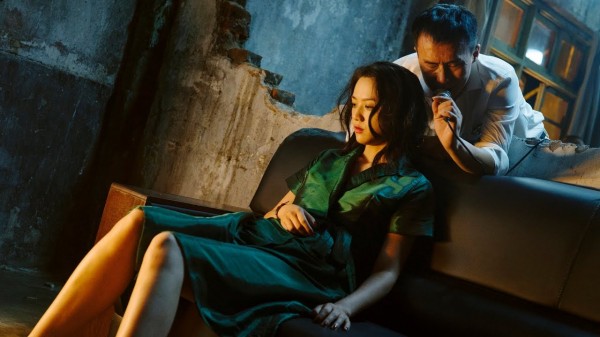
TANG WEI AND HUANG JUE IN LONG DAY'S JOURNEY INTO NIGHT
Bi Gan's astonishing second feature is a technical wonder, with some loss of emotional force from his first
Debuted at the Cannes Festival last year, now being distributed in the US by Kino Lorber, Long Day's Journey Into Night is the much-anticipated second feature of the young Chinese auteur Bi Gan, whose 2016 Kaili Blues wowed cinephiles and was the greatest astonishment of that year's New Directors/New Films. (It debuted at Locarno, where ND/NF gets a lot of its finds.) Bi Gan's talent (and he was only 25 when he shot the film) didn't go unnoticed, and for this sophomore effort the southeastern China resident (Kaili, his hometown, is the setting of both of these films) received ample funding and was able to cast well-known names. The critical reaction has been even more enthusiastic than for Kaili Blues. This is certainly an amazing picture that stands out from the crowd, and I relished it, and will want to re-watch it. But it's so highly wrought it seems a bit labored; it isn't as much fun as the first one and doesn't provide the same sense of discovery.
Bi's new film is so highly referential and self-consciously made, it may serve better as material for a film scholar's research thesis than audience enjoyment. It's also in two distinct parts that are almost like two separate movies with the same main character. It'snot clear the two parts interact successfully. The first is a recollection and a journey. The second is (perhaps) a dream, and it's in 3D.
The main character of Journey, both parts, is Luo Hongwa (Huang Jue), a man on his way back to Kaili after a long absence - like the doctor protagonist of Kaiil Blues, Chen Sheng (Chen Yongzhong), who was going back to Kaili in to locate his nephew. Luo is a middle-aged man, returning in search of Wan Qiwen (Lust, Caution star Tang Wei), a sexpot he had a memorable affair with at the turn of the century and has not heard of since. The first half strongly evokes the style and mood of Wong Kar-wai. The influence hits you right away with the twangy, nostalgic music, the shabby-chic, colorfully lit sets, the sweaty, sexy people half undressed and puffing on cigarettes. Bi wears his influences on his sleeve. Tarkovsky comes to mind for some, and Bi himself has acknowledged many others. He relishes allusions. Hence the obvious one to Eugene O'Neill in the English title (his choice, evidently), though this has nothing to do with O'Neill's play, but makes an evocative reference to the action and mood. The Chinese title is said to be an allusion to the English title of Chilean novelist Roberto Bolaño's story collection Llamadas Telefónicas, Last Evenings on Earth.
This is a slow journey and a dream journey. Thoughts, feelings, and shifts around in time occupy the foreground, rather than narrative action. This film is steeped in style. The strong references to Wong Kar-wai at first both boldly declare that influence, and reveal this is a very different filmmaker. We don't get Wong's rapid movement and sense of fun, but instead a droning, intense, almost hypnotic mood. The romance flashbacks are beautiful: the color, the lighting, the sets of attractively disintegrating places; also the style in which they're photographed. Three different cinematographers worked on the film, Yao Hung-I, Dong Jinsong, and Frenchman David Chizallet. The scenes are richly evocative: Jordan Mintzer (in hisHollywood Reporter review) finds the great, elaborately lived-in sets of art director Liu Qiang reminiscent of those born of the long term collaboration between Wong Kar-wai and his production designer, William Chang.
The opening 75 minutes focus on the love affair of Luo and Wan. They met in an abandoned house in the year 2000, then sought to escape from Wan's gangster boyfirend Zuo Hongyan (Chen Yongzhong). Another recurrent tale is if the couple's gangster pal Wildcat (Lee Hong-Chi), who was murdered. It was true also of Kaili Blues that gangsters are at the periphery, as if to add glamour and a whiff of danger. These aren't gangster movies, but they have a distinct neo-noir cast to them. Luo carries a pistol. He has a doomed quality. Everybody smokes a lot in the dramatically lit shadows. The mood is almost hypnotic - again, without Wong Kar-wai's quick shifts. Long takes are the thing - which, of course, means another influence, one of which might be Hou Hsiao-Hsien.
Looking for Wan now, Luo comes to a ruined or demolished town on the hills above Kaili. He wants to enter a semi-outdoor karaoke bar and play, but is told he must wait an hour, and should while away the time in a movie. So he enters a shabby cinema, sits down. And he puts on big dark glasses. This is the signal the audience has been prepared for with an opening title, to put on the 3D glasses they were given, because now the second part begins, in 3D. And it is not only in 3D, but also, like the virtuoso last 40 minutes of Kaili Blues, is one long, continuous take.
That long take was what made you realize Kaili Blues was something truly unique and magical. It was done, as here - except this one is more elaborate and more shot semi-indoors - with the use of drones and digital fusion so skillful that if there are any breaks, we can't detect them. Such a long take, as Bi Gan does it, has a remarkable double effect. at once hyper-artificial, and hyper-real. It's artificial: one is aware every minute of observing a technical feat. At the same time it makes one identify so strongly with the camera that it heightens the sense of "being there."
This contradictory effect isn't necessarily anything new. When you watch a movie, you are always aware it's a movie, while at the same time you're up in the action. If somebody on screen is about to fall off a cliff, you catch your breath as if you were on the edge of a precipice yourself. But the 3D long-take presentation is trippier. It's movie-watching on acid.
We don't know if this segment is a dream or another film, perhaps Luo's film. It's also a nightmare. Luo gets caught in a tunnel, and gets set free by a younger version of Wildcat (Lui Feiyang), whom Luo beats at ping pong, then accompanies on a long scooter ride (as in Kaili Blues' long take), followed by a zip-line ride into town, where there is seemingly an all-night festival outdoors in a ruined space. This reminded me of the phantasmagoric, disturbing opening sequence of Stephen Spielberg's A.I. All along one is marveling at the incredible coordination of complicated activities that it took to film all this in a single take. As Mintzer notes, "Perhaps the craziest moment is when Luo wanders into an old pool hall and makes a bet with a punkish teenager who, if he messes up his tricky combination shot, would seemingly ruin the whole sequence. It’s a wager that only an uncompromising young auteur like Bi could make." But this illustrates the point of Giovanni Marchini Camia in The Film Stage that Journey, compared to Kaili Blues, besides being "a far more polished work," unfortunately also "feels a lot more calculated, often sacrificing emotional impact for ostentation."
I didn't mind the first part's strong debut to Wong Kar-wai. Wong was my greatest film discovery of the Nineties and possibly the reason why I even bother to write film reviews. Those early scenes do evoke a lot of emotion, even though it gets lost sometimes in the elaborate references and obsession with visual beauty and the somewhat somnolent pace. But in the second half, despite some great little sequences, with the ping pong kid and the young punks, in particular, and then the two women, and the sparkler, the return to which is both the triumphant final coup of the single take and the affirmation of the transitory nature of all life - all makes me feel more like I'm walking a tightrope than watching a movie. Like the filmmaker, Bi Gan is testing himself, but also testing me. Instead of enlightening me. But the graduate theses will explain why I should be enlightened, no doubt.
Long Day's Journey Into Night/地球最后的夜晚 (Di qiu zui hou de ye wan), 138 mins., debuted at Cannes 2018 (Un Certain Regard), and played at about two dozen other international festivals, including Toronto, New York, Vancouver, Taipei and Rotterdam. Limited US theatrical release began 12 Apr. 2019. Metascore 88% (Kaili Blues was 85%).
Last edited by Chris Knipp; 04-26-2019 at 05:45 PM.
-
-
RAY & LIZ (Richard Billingham 2018)
RICHARD BILLINGHAM: RAY & LIZ (2018)
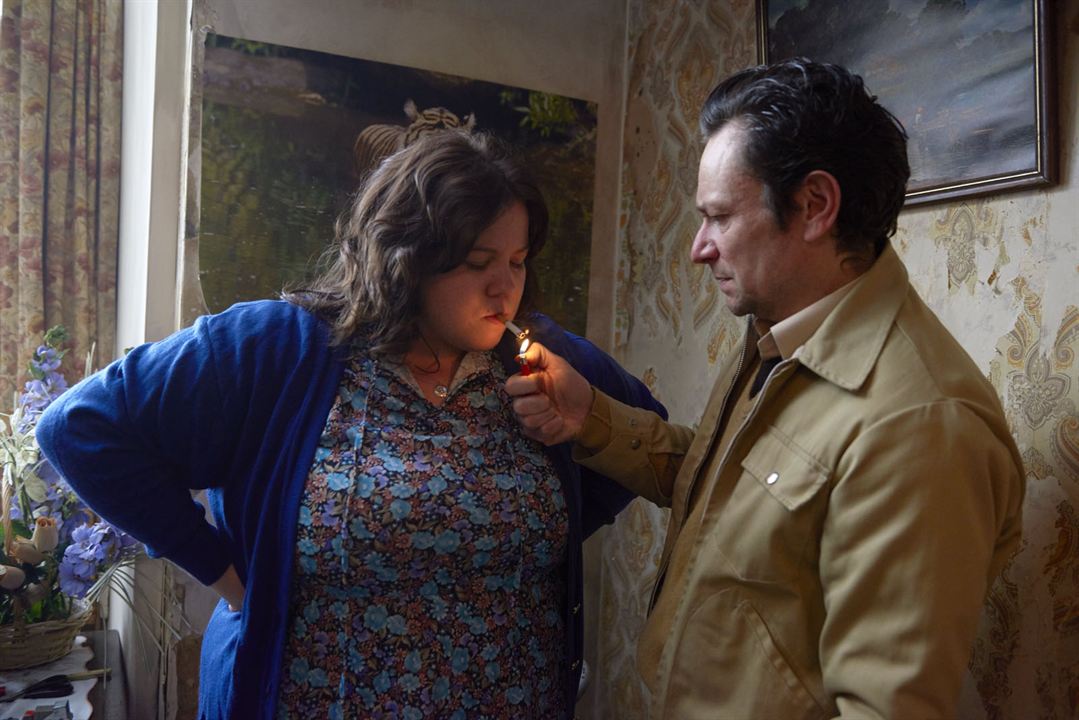
ELLA SMITH, JUSTIN SALINGER AS THE YOUNGER RAY & LIZ IN RAY & LIZ
An eye for surfaces
"They will have a Costa coffee cup, or a pre-packed sandwich that someone has given them, and the digital camera can render those modern surfaces and plastics really well. But the film camera is much better for older surfaces." Billinmgham, whose snapshots of his alcoholic father and tatooed, bilious mother ("Ray's a Laugh") led him to a Turner Prize nomination and a career as an art photographer, said that in a Guardian interview about photographing homeless people, vs., say, the squalid Birmingham Tower flat he grew up in. This reflects his delicate eye, his sensitivity to visual media. The feature film that he made, going back to decades ago, is shot with film, 16mm. It's also pitched in boxy Academy ratio shot by dp Daniel Landin (Under the Skin, The Yellow Birds), which makes you the more appreciative of the sensitive framing of images in the film that sometimes look like old paintings, intimiste ones. All that tempers the squalor, perhaps, though Billingham extenuates nothing, and in doing so, thinks Matthieu Macheret of Le Monde, can be "at once tender and cruel, loving and ruthless," thus evading "miserabilism or watering down."
The film jumps around in time, visiting the filmmaker at two stages of his young life, and narrative is not always the strong point: one should appreciate that Billingham, however ruthless about the neglect and mess he was forced to grow up in, remains an intimist painter of small portraits. Several scenes are memorable. His mother goes out with him to shop for shoes, leaving the half-witted Uncle Lol (Tony Lay) to mind his baby brother, Jason. A mean teenager called Will (Sam Gittins) comes in and maliciously gets Lol dead drunk, handing little Jason a kitchen knife to play with. A longhaired neighbor, Sid (Richard Ashton) regularly brings in three pop bottles full of his home brew and tucks them tenderly beside Ray on the bed to begin his day. They talk of flies, which we view, intimately, a visual theme. They seem to swarm around. This is the older Ray, played by Patrick Romer, living on his own, and the first of a triptych of sections. The one with younger Ray shows him living with Liz in a rundown tenement house in a Midlands town near Birmingham.
Jason, the greatest victim of this uncaring, irresponsible childrearing, drops a toy soldier down on a walker below, and tips a tablespoon of chili pepper into sleeping Ray's mouth. He feeds himself, making a sandwich of white bread filled with a few pieces of pickled cabbage from a giant jar. Billingham has said Jason often tells him "Statistically, we should be in prison, dead or homeless." This moment is when Jason, played by Millard-Lloyd, is 7 or 8 and Richard (Sam Plant) is 15, and they're living in an equally trashed tower block flat. This in time is shortly before Jason was taken into foster care after being lost for days and turning up asleep in a shed without their parents even noticing.
Each abode has animals, dogs, a parakeet, a rabbit, snails Jason keeps under his bed, that seem to haunt and reproach the spaces and add to the sense of intimacy, coziness amid the squalor. Yes, squalor, which impinges on us, can be cozy. Books do furnish a room; so does trash.
Also memorable is the chubby young Liz (Ella Smith), with her special way of holding her constantly lit cigarettes, and her flowered dress, blending with the complicated texture of a big jigsaw puzzle perched in front of her ample bosom. I could not help amid this very English grunginess, thinking of Vuillard and Bonnard, so pleasing is the light in Landin's images. so delicate the color, so nicely arranged the objects in the square.
Billingham and Landin also provide escapes. A trip outside to watch fireworks on Guy Fawkes Day, another in daytime on a funicular to visit a zoo. Billingham has said he and Jason are alive due to luck plus a love of nature nurtured by David Attenborough documentaries and their annual childhood visits with Liz to Dudley Zoo, "the highlight of his year." Watch how the long neck of a giraffe are criss-corssed in the frame with the squat head of the boy seen from behind.
With this brilliantly original, stunningly visual, emotionally precise film Richard Billingham has made a debut feature that's an instant classic, and joins the likes of Andrea Arnold, Lynne Ramsay, and Shane Meadows, British filmmakers whose harsh realism achieves subtle, haunting life suffused with love.
Ray & Liz, 108 mins., debuted at Locarno Aug. 2028 and was included in 30 other international festivals, including Toronto, New York, and London. It was nominated for a BAFTA Outstanding Debut award, and won numerous others. Theatrical release Mar. 2019 in the UK, 10 Apr. in France (AlloCiné press rating 3.4). Metascore 81%. Out on Digital and On-Demand from KimStim/1091 Media on April 14, 2020.
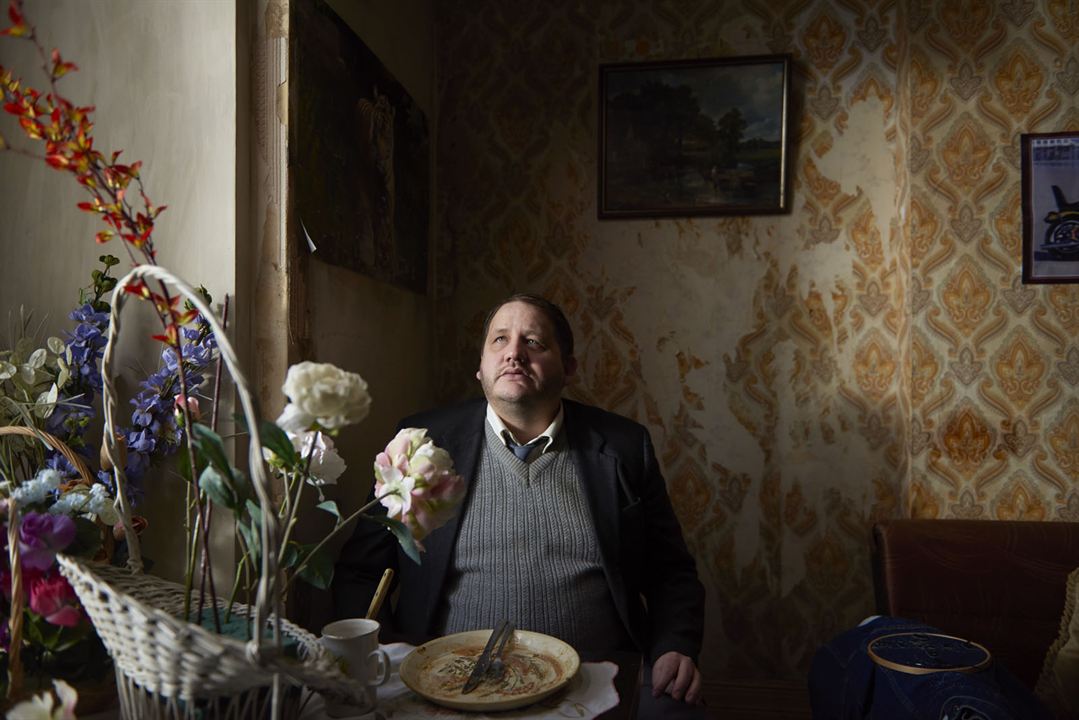
TONY WAY AS UNCLE LOL IN RAY & LIZ
Last edited by Chris Knipp; 04-12-2020 at 06:22 PM.
 Posting Permissions
Posting Permissions
- You may not post new threads
- You may not post replies
- You may not post attachments
- You may not edit your posts
-
Forum Rules





 Reply With Quote
Reply With Quote
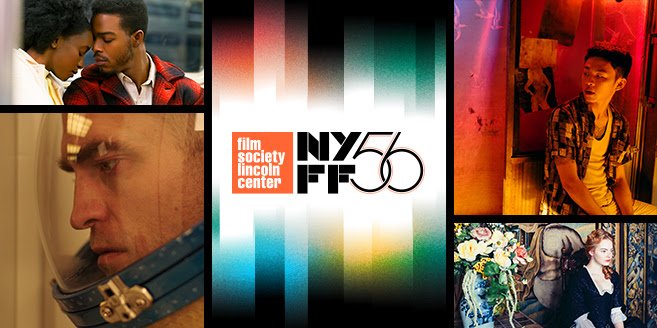



Bookmarks